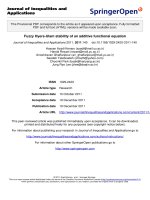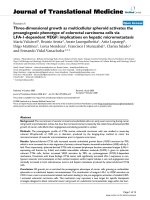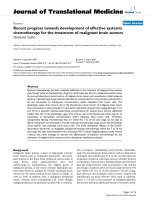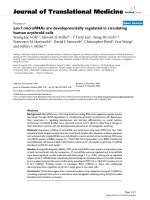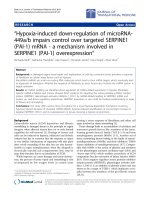báo cáo hóa học: " Tumor necrosis factor-mediated inhibition of interleukin-18 in the brain: a clinical and experimental study in head-injured patients and in a murine model of closed head injury." pot
Bạn đang xem bản rút gọn của tài liệu. Xem và tải ngay bản đầy đủ của tài liệu tại đây (286.09 KB, 6 trang )
BioMed Central
Page 1 of 6
(page number not for citation purposes)
Journal of Neuroinflammation
Open Access
Short report
Tumor necrosis factor-mediated inhibition of interleukin-18 in the
brain: a clinical and experimental study in head-injured patients and
in a murine model of closed head injury.
Oliver I Schmidt
1
, Maria Cristina Morganti-Kossmann
2
, Christoph E Heyde
1
,
Daniel Perez
3
, Ido Yatsiv
4
, Esther Shohami
4
, Wolfgang Ertel
1
and
Philip F Stahel*
1
Address:
1
Department of Trauma and Reconstructive Surgery, Charité University Medical School, Campus Benjamin Franklin, Berlin, Germany,
2
Department of Trauma Surgery, The Alfred Hospital, Monash University, Melbourne, Australia,
3
Department of Surgery, University Hospital
Zurich, Switzerland and
4
Department of Pharmacology, The Hebrew University, Hadassah Medical School, Jerusalem, Israel
Email: Oliver I Schmidt - ; Maria Cristina Morganti-Kossmann - ;
Christoph E Heyde - ; Daniel Perez - ; Ido Yatsiv - ;
Esther Shohami - ; Wolfgang Ertel - ; Philip F Stahel* -
* Corresponding author
Closed head injuryinflammationcytokinesTNFinterleukin-18.
Abstract
Tumor necrosis factor (TNF) and interleukin-(IL)-18 are important mediators of
neuroinflammation after closed head injury (CHI). Both mediators have been previously found to
be significantly elevated in the intracranial compartment after brain injury, both in patients as well
as in experimental model systems. However, the interrelation and regulation of these crucial
cytokines within the injured brain has not yet been investigated. The present study was designed
to assess a potential regulation of intracranial IL-18 levels by TNF based on a clinical study in head-
injured patients and an experimental model in mice. In the first part, we investigated the
interrelationship between the daily TNF and IL-18 cerebrospinal fluid levels in 10 patients with
severe CHI for up to 14 days after trauma. In the second part of the study, the potential TNF-
dependent regulation of intracerebral IL-18 levels was further characterized in an experimental set-
up in mice: (1) in a standardized model of CHI in TNF/lymphotoxin-α gene-deficient mice and wild-
type (WT) littermates, and (2) by intracerebro-ventricular injection of mouse recombinant TNF in
WT C57BL/6 mice. The results demonstrate an inverse correlation of intrathecal TNF and IL-18
levels in head-injured patients and a TNF-dependent inhibition of IL-18 after intracerebral injection
in mice. These findings imply a potential new anti-inflammatory mechanism of TNF by attenuation
of IL-18, thus confirming the proposed "dual" function of this cytokine in the pathophysiology of
traumatic brain injury.
Published: 28 July 2004
Journal of Neuroinflammation 2004, 1:13 doi:10.1186/1742-2094-1-13
Received: 18 June 2004
Accepted: 28 July 2004
This article is available from: />© 2004 Schmidt et al; licensee BioMed Central Ltd. This is an open-access article distributed under the terms of the Creative Commons Attribution
License ( />), which permits unrestricted use, distribution, and reproduction in any medium, provided the original
work is properly cited.
Journal of Neuroinflammation 2004, 1:13 />Page 2 of 6
(page number not for citation purposes)
Findings
Closed head injury (CHI) is the leading cause of mortality
and persisting neurological impairment in young people
in industrialized countries [1,2]. The neuropathological
sequelae of brain injury are mediated in large part by a
profound host-mediated intracranial inflammatory
response [3-5]. The pro-inflammatory cytokines tumor
necrosis factor (TNF) and interleukin (IL)-18 have been
identified as crucial mediators of neuroinflammation
after brain injury [6-9]. This notion has been supported by
experimental studies in rodents which demonstrated neu-
roprotective effects by pharmacological inhibition of
either TNF or IL-18 after CHI [9-11]. In recent years, the
concept of a "dual role" evolved with regard to concomi-
tant beneficial and adverse effects of pro-inflammatory
mediators, depending on the kinetic of their expression
and posttraumatic regulation in the injured brain
[3,12,13]. However, the TNF-dependent regulation of IL-
18 in the injured brain has not yet been investigated. We
sought to determine the interrelationship between intrac-
ranial TNF and IL-18 levels in a clinical study on patients
with severe CHI and in an experimental model in mice.
Patients with isolated severe closed head injury (n = 10,
Glasgow Coma Scale score ≤ 8) and indication for intra-
ventricular catheters for cerebrospinal fluid (CSF) drain-
age due to increased intracranial pressure (ICP > 15 mm
Hg) were included in this study. Drained CSF was col-
lected daily for up to 14 days after trauma or until cathe-
ters were removed. The patient characteristics are shown
in Table 1. No patient was treated with steroids. The pro-
tocol for daily CSF collection is in compliance with the
Helsinki Declaration and was approved by the Univer-
sity's Ethics Board Committee. Control CSF was collected
from patients undergoing diagnostic spinal tap (n = 10)
and revealed no inflammatory CNS disease, based on nor-
mal CSF protein and glucose levels and normal white cell
counts. All samples were kept on ice at 4°C and immedi-
ately centrifuged after collection, aliquoted, and frozen at
-70°C until analysis.
Quantification of IL-18 and TNF levels in human CSF
samples and in murine brain homogenates was per-
formed by species-specific commercially available ELISA
(R&D Systems, Abingdon, UK). According to the informa-
tion provided by the manufacturer, the IL-18 assay recog-
nizes both the mature and the pro-form of IL-18. All
concentrations below the detection limit of 5 pg/mL (IL-
18) or 1 pg/ml (TNF) were assigned a value of 5 pg/mL,
and 1 pg/ml respectively. All samples were run undiluted
in duplicate wells. The concentrations were calculated
from the mean OD of duplicate samples, determined by
spectrophotometer (Dynatech Laboratories Inc., Chant-
illy, VA, U.S.A.) at an extinction wavelength of 405 nm.
The experimental part of the study was set-up on two dif-
ferent protocols with the aim to assess the TNF-dependent
regulation of IL-18 in the murine brain:
(1) The first part of the experimental study was designed
to investigate a potential role of TNF-dependent regula-
tion of intracranial IL-18 expression in a standardized
model of CHI, using mice double-deficient in genes for
TNF and lymphotoxin-α (TNF/LT-α-/-) [14]. These knock-
out mice were selected in order to compensate for poten-
tial redundant functions of TNF by LT-α which binds to
Table 1: Clinical data and intrathecal cytokine levels in patients with severe closed head injury.
Patient Age (years) /
Gender
Type of brain injury
(Marshall score)
Outcome
(GOS)
TNF in CSF (pg/mL) IL-18 in CSF (pg/mL) Correlation r
S
Mean Range Mean Range
1 38 / M EML 4 6.4 1.0 – 11.5 40.6 6.5 – 155.2 - 0.804 **
2 30 / M DI II° 3 3.6 1.0 – 7.7 114.3 29.7 – 286.4 - 0.580 *
3 56 / M EML 4 6.3 1.0 – 10.0 35.1 11.2 – 100.3 - 0.530
4 57 / F DI II° 5 6.0 1.0 – 11.7 20.1 5.0 – 168.8 - 0.761 **
5 44 / M EML 4 1.6 1.0 – 3.4 39.8 22.6 – 74.5 - 0.751 *
6 26 / M EML 4 3.2 1.0 – 10.3 108.5 5.0 – 328.6 - 0.832 **
7 47 / M EML 1 1.1 1.0 – 1.4 268.5 78.3 – 462.0 - 0.372
8 25 / M EML 4 2.2 1.0 – 4.0 91.6 10.3 – 290.0 - 0.195
9 37 / F DI III° 3 1.6 1.0 – 2.7 183.7 21.5 – 382.2 - 0.844 **
10 35 / M DI II° 4 2.0 1.0 – 5.8 209.4 19.9 – 391.8 - 0.772 *
Controls (n = 10) 1.0 1.0 – 7.1 5.0 5.0 – 8.4
Statistical analysis for assessment of the correlation between tumor necrosis factor (TNF) and interleukin (IL)-18 levels in serial cerebrospinal fluid
samples for up to 14 days after trauma was performed by Spearman's rank correlation (*P < 0.05, **P < 0.01). The patients' outcome was
determined at 3 months after injury by the Glasgow Outcome Scale (GOS) score [33]: 5 = asymptomatic, 4 = moderate disability, 3 = severe
disability, 2 = persisting vegetative state, 1 = death. The type of brain injury was classified by the CT-scan criteria established by Marshall et al. [34]
into diffuse injury (DI) grade I-III and evacuated vs. non-evacuated mass lesions (EML, NEML).
Journal of Neuroinflammation 2004, 1:13 />Page 3 of 6
(page number not for citation purposes)
the identical common receptors (i.e. TNF receptors p55
and p75) [14-16]. The generation and development of the
TNF/LT-α-/- mice on a mixed C57BL/6 × 129Sv/Ev (B6 ×
129) genetic background has been previously described
[14]. Knockout mice and wild-type (WT) littermates of the
B6 × 129 strain were subjected to a CHI (n = 10 per group)
using a standardized weight-drop model, as previously
described [9,17]. In brief, following ether anesthesia, a
midline longitudinal scalp incision was performed.
Trauma was applied to the left anterior frontal area of the
exposed skull by a 330 g weight with a silicon tip dropped
from a height of 2 cm, resulting in a focal closed injury to
the left hemisphere. Mice received supporting oxygena-
tion with 100% O
2
until they awakened and were then
brought back to their cages. Control animals were sub-
jected to anesthesia and sham operation only (n = 10 per
group). In addition, mice with anesthesia alone (n = 8)
were used as internal control and untreated control ani-
mals (n = 10) were analyzed for baseline evaluation of
intracerebral cytokine profiles in these mice.
(2) In the 2
nd
part of the experimental study, mice of the
C57BL/6 strain (n = 10 per group) were treated by stereo-
tactic intracerebroventricular (i.c.v.) injection of either
200 ng mouse recombinant TNF in 10 µl PBS, or vehicle
solution only (10 µl PBS), into the left hemisphere using
a sterile 27-gauge syringe, under ether anesthesia. Accord-
ing to data from previously published studies [18-20], as
well as based on titration studies from our own labora-
tory, the i.c.v. injection of 200 ng mouse-recombinant
TNF (R&D Systems) elicited an evident induction of
inflammatory changes in the murine CNS, such as intrac-
ranial recruitment of leukocytes and development of
brain edema in the injected hemisphere within 24 hours
(data not shown). Animals from all groups (CHI and i.c.v.
injection) were sacrificed at 24 h after the respective pro-
cedure, which corresponds to the time-point of maximal
extent of intracerebral inflammation in the model of CHI
used in this study [17].
For assessment of intracerebral IL-18 levels, the murine
brains were immediately removed after decapitation. Tis-
sue homogenization was performed using a Polytron
homogenizer (Kinematica, Kriens, Switzerland) with a
dilution of 1:4 in ice cold extraction buffer containing 50
mmol/L Tris buffer (pH 7.2), NaCl 150 mmol/L, Triton-X-
100 1%, and protease inhibitor cocktail (Roche, Man-
nheim, Germany). The homogenates were shaken on ice
for 90 minutes, centrifuged for 15 minutes at 3,000 g and
4°C. Thereafter, the supernatants were aliquoted and
stored at -70°C until analysis. The concentrations of total
protein in the brain extracts were measured by Bradford
assay (Bio Rad Laboratories, Munich, Germany). The
intracerebral protein concentrations were in a similar
range in all mice assessed (11.7 ± 2.4 mg/mL; mean ± SD).
The quantification of IL-18 levels in murine brain
homogenates was performed as described above for the
human samples. All mice used in this study were males, in
order to avoid a bias in gender, age 12 to 16 weeks with
body weights of 25 to 32 g. The animal experiments were
performed in compliance with the guidelines of the Fed-
eration of European Laboratory Animal Science Associa-
tion (FELASA) and approval was granted by the
Institutional Animal Care Committee of the University of
Zurich and of the Hebrew University of Jerusalem.
In the clinical part of the study on CHI patients, the mean
IL-18 concentrations in ventricular CSF collected up to 14
days after trauma were significantly higher than in control
lumbar CSF from patients undergoing diagnostic spinal
tap (P< 0.05, repeated measures ANOVA; Table 1). These
findings are coherent with data from previously published
studies which demonstrated significantly elevated intrac-
ranial IL-18 levels after brain injury, both in humans as
well as in experimental model systems [8,9]. With regard
to TNF, the mean levels in individual serial cerebrospinal
fluid samples were significantly elevated in 50% of all
head-injured patients, compared to controls (patients
#1,2,3,4,6; Table 1). Elevated intracranial TNF levels after
traumatic brain injury have been previously reported in
various clinical and experimental studies [21-26]. In the
present study, the individual daily TNF levels in CSF were
up to 10- to 100-fold lower than the corresponding IL-18
levels (Table 1). Interestingly, despite the fairly low TNF
levels in CSF we found an inverse correlation between the
daily individual intrathecal TNF and IL-18 levels in all
trauma patients, as demonstrated by a negative Spear-
man's rank correlation coefficient (r = -0.195 to -0.844).
In 7 of 10 patients, this inverse correlation was statistically
significant, with a P-value < 0.05 in three patients (#
2,5,10) and P < 0.01 in four patients (# 1,4,6,9; Table 1).
Since the quality of the blood-brain barrier has not been
determined in this cohort of head-injured patients, due to
the lack of matching serum samples for assessment of
albumin levels, the source of elevated cytokines (intrathe-
cal compartment vs. peripheral serum) remains unclear.
In the experimental study, IL-18 was found to be constitu-
tively expressed in the brain of untreated mice (27.7 ± 5.4
ng/mL, mean ± SEM; "baseline", Fig. 1), which is in
accordance with data from previous studies revealing con-
stitutive IL-18 expression in the CNS of normal rats and
mice [8,9,27,28]. Microglia may represent the cellular
source of constitutive intracranial IL-18 levels in these
mice, since Prinz and colleagues have previously shown
that microglial cells, but not astrocytes, produce IL-18 in
the murine CNS [28]. The intracerebral IL-18 levels
increased significantly in the head-injured group by 24
hours after experimental CHI (56.9 ± 4.7 ng/mL, P < 0.01
vs. baseline, Fig. 1). Knockout mice lacking TNF and LT-α
Journal of Neuroinflammation 2004, 1:13 />Page 4 of 6
(page number not for citation purposes)
genes also showed significantly elevated IL-18 concentra-
tions at 24 h after CHI (58.4 ± 7.8 ng/mL) which were in
a similar range as in head-injured WT mice, as shown in
Fig. 1. This lack of differences in mice deficient in the lig-
ands for TNF receptors may be explained by alternatively
expressed inflammatory mediators or modified pathways
of IL-18 regulation in these genetically engineered mice
which have been shown to have significantly altered
immune responses [14]. Interestingly, the intracerebral
injection of vehicle alone (10 µl PBS i.c.v.) induced signif-
icantly elevated IL-18 levels in brains of normal WT mice,
compared to normal untreated mice, which were in a sim-
ilar range as in the brain-injured groups (53.6 ± 9.6 ng/ml,
Fig. 1). These data imply that a minor penetrating injury
by i.c.v. injection of a small volume of buffer solution rep-
resents a procedure which is sensitive enough to induce
significant IL-18 production in murine brains within 24
hours. In contrast, the intracerebral injection of murine
Intracerebral IL-18 concentrations in mice, as determined by ELISA in murine brain homogenates (n = 10 animals per group)Figure 1
Intracerebral IL-18 concentrations in mice, as determined by ELISA in murine brain homogenates (n = 10 animals per group).
Untreated normal mice were used for determination of baseline IL-18 levels in this study. The four treatment groups were sac-
rificed after 24 hours for assessment of intracerebral IL-18 levels, as described in the text. Mice deficient in genes for TNF and
lymphotoxin-α (TNF/LT-α-/-) and wild-type (WT) littermates were subjected to focal closed head injury (CHI) and sacrificed
after 24 hours. Two additional groups of WT mice were given an intracerebro-ventricular (i.c.v.) injection of 200 ng mouse-
recombinant TNF in 10 µl PBS or by vehicle alone (10 µl PBS i.c.v.). The data are presented as means ± SEM. *P < 0.01 vs. base-
line / TNF-injection (unpaired Student's t-test).
0
10
20
30
40
50
60
70
80
90
Intracerebral IL-18 (ng/ml)
Baseline CHI CHI vehicle TNF
WT TNF/LT-D-/- injection injection
*
*
*
Journal of Neuroinflammation 2004, 1:13 />Page 5 of 6
(page number not for citation purposes)
recombinant TNF (in 10 µl PBS) reduced the elevated IL-
18 levels in murine brains significantly to levels than were
even lower than baseline concentrations (22.13 ± 7.1, P <
0.01 vs. vehicle-injected mice), as shown in Fig. 1.
The findings from these experimental investigations cor-
roborate the data from the clinical study, where an inverse
correlation of intrathecal TNF and IL-18 levels during the
first 14 days after severe CHI was found, suggesting that
the inhibition of IL-18 may represent a new potential anti-
inflammatory mechanism after CHI. Such a "dual role" of
TNF has been suggested previously in terms of concomi-
tant pro- and anti-inflammatory effects and detrimental as
well as beneficial neuroprotective properties after brain
injury [12]. While the pro-inflammatory effects mediated
by TNF in the CNS have been thoroughly investigated in
the past two decades [15,29,30], the concept of anti-
inflammatory effects mediated by cytokines which have
been formerly designated as "pro-"inflammatory media-
tors, is still challenging and novel. Scherbel and col-
leagues were the first to provide evidence of beneficial
effects of TNF in the later phase (i.e. 4 weeks) after trau-
matic brain injury, based on studies in TNF-/- mice sub-
jected to controlled cortical impact brain injury [31]. In
these experiments, the TNF-deficient mice showed a sig-
nificantly attenuated neurobehavioral impairment than
WT littermates in the first 48 hours post trauma, in terms
of early detrimental effects mediated by TNF [31]. How-
ever, the expected neurobehavioral recovery was absent in
TNF-/- mice after 4 weeks and cortical tissue loss was sig-
nificantly increased at this time-point, compared to WT
littermates, implying that at later time-points the lack of
TNF leads to adverse outcome after brain injury [31].
Barger and colleagues have previously shown in an in vitro
model of amyloid β-mediated neurotoxicity that both
TNF and LT-α (formerly designated TNF-β) can signifi-
cantly attenuate neuronal degeneration by induction of
antioxidative pathways through activation of the tran-
scription factor NFκb, thus strengthening the notion of
neuroprotective effects mediated by these cytokines [32].
This assumption was further corroborated in the setting of
experimental CHI, where mice lacking both TNF and LT-
α genes were shown to have a significantly increased mor-
tality within one week after trauma, compared to WT lit-
termates [17]. Overall, these data support the notion that
TNF exerts detrimental effects in the early phase and ben-
eficial neuroprotective effects in the later phase after head
injury [12]. However, the assumptive underlying regula-
tory mechanisms of TNF-mediated neuroprotection and
of TNF-mediated suppression of IL-18 in the injured brain
remain unclear and have to be investigated in future
experimental studies.
List of abbreviations
Central nervous system (CNS), cerebrospinal fluid (CSF),
closed head injury (CHI), intracerebroventricular (i.c.v.),
interleukin (IL), lymphotoxin-α (LT-α / TNF-β), nuclear
factor κB (NFκB), tumor necrosis factor (TNF), phos-
phate-buffered saline (PBS), intracranial pressure (ICP),
wild-type (WT), enzyme-linked immunosorbent assay
(ELISA).
Competing interests
There are no financial interests by any of the authors with
regard to the present project.
Authors' contributions
OIS, MCMK, CEH, ES, and PFS were responsible for con-
ception and planning of the experiments, as well as for
performing the animal experiments, collection of the
human cerebrospinal fluid samples and cytokine meas-
urements in human and murine tissue samples, as well as
for writing of the manuscript. DP and IY performed the
experimental i.c.v. injection experiments. WE contributed
to the interpretation of the results and writing of the
manuscript.
Acknowledgments
The authors thank Dr. Hans-Pietro Eugster (Division of Clinical Immunol-
ogy, University of Zurich, Switzerland) for providing the TNF/lymphotoxin-
α knockout mice. Dr. Volkmar Hans (Department of Neuropathology,
Gilead Clinic, Bielefeld, Germany) is acknowledged for critical review of the
manuscript.
References
1. Marshall LF: Head injury: recent past, present, and future. Neu-
rosurgery 2000, 47:546-561.
2. Bayir H, Clark RS, Kochanek PM: Promising strategies to mini-
mize secondary brain injury after head trauma. Crit Care Med
2003, 31:S112-7.
3. Morganti-Kossmann MC, Rancan M, Stahel PF, Kossmann T: Inflam-
matory response in acute traumatic brain injury: a double-
edged sword. Curr Opin Crit Care 2002, 8:101-105.
4. Ransohoff RM: The chemokine system in neuroinflammation:
an update. J Infect Dis 2002, 186 Suppl 2:S152-6.
5. Barnum SR: Complement in central nervous system
inflammation. Immunol Res 2002, 26:7-13.
6. Hedtjarn M, Leverin AL, Eriksson K, Blomgren K, Mallard C, Hagberg
H: Interleukin-18 involvement in hypoxic-ischemic brain
injury. J Neurosci 2002, 22:5910-5919.
7. Jander S, Schroeter M, Stoll G: Interleukin-18 expression after
focal ischemia of the rat brain: association with the late-
stage inflammatory response. J Cereb Blood Flow Metab 2002,
22:62-70.
8. Menge T, Jander S, Stoll G: Induction of the pro-inflammatory
cytokine interleukin-18 by axonal injury. J Neurosci Res 2001,
65:332-339.
9. Yatsiv I, Morganti-Kossmann MC, Perez D, Dinarello CA, Novick D,
Rubinstein M, Otto VI, Rancan M, Kossmann T, Redaelli CA, Trentz
O, Shohami E, Stahel PF: Elevated intracranial IL-18 in humans
and mice after traumatic brain injury and evidence of neuro-
protective effects of IL-18-binding protein after experimen-
tal closed head injury. J Cereb Blood Flow Metab 2002, 22:971-978.
10. Shohami E, Bass R, Wallach D, Yamin A, Gallily R: Inhibition of
tumor necrosis factor alpha (TNFalpha) activity in rat brain
is associated with cerebroprotection after closed head
injury. J Cereb Blood Flow Metab 1996, 16:378-384.
Publish with BioMed Central and every
scientist can read your work free of charge
"BioMed Central will be the most significant development for
disseminating the results of biomedical research in our lifetime."
Sir Paul Nurse, Cancer Research UK
Your research papers will be:
available free of charge to the entire biomedical community
peer reviewed and published immediately upon acceptance
cited in PubMed and archived on PubMed Central
yours — you keep the copyright
Submit your manuscript here:
/>BioMedcentral
Journal of Neuroinflammation 2004, 1:13 />Page 6 of 6
(page number not for citation purposes)
11. Shohami E, Gallily R, Mechoulam R, Bass R, Ben-Hur T: Cytokine
production in the brain following closed head injury: dex-
anabinol (HU-211) is a novel TNF-alpha inhibitor and an
effective neuroprotectant. J Neuroimmunol 1997, 72:169-177.
12. Shohami E, Ginis I, Hallenbeck JM: Dual role of tumor necrosis
factor alpha in brain injury. Cytokine Growth Factor Rev 1999,
10:119-130.
13. Lenzlinger PM, Morganti-Kossmann MC, Laurer HL, McIntosh TK:
The duality of the inflammatory response to traumatic brain
injury. Mol Neurobiol 2001, 24:169-181.
14. Eugster HP, Müller M, Karrer U, Car BD, Schnyder B, Eng VM,
Woerly G, Le Hir M, di Padova F, Aguet M, Zinkernagel R, Blueth-
mann H, Ryffel B: Multiple immune abnormalities in tumor
necrosis factor and lymphotoxin-alpha double-deficient
mice. Int Immunol 1996, 8:23-36.
15. Wallach D, Varfolomeev EE, Malinin NL, Goltsev YV, Kovalenko AV,
Boldin MP: Tumor necrosis factor receptor and Fas signaling
mechanisms. Annu Rev Immunol 1999, 17:331-367.
16. Probert L, Akassoglou K, Kassiotis G, Pasparakis M, Alexopoulou L,
Kollias G: TNF-alpha transgenic and knockout models of CNS
inflammation and degeneration. J Neuroimmunol 1997,
72:137-141.
17. Stahel PF, Shohami E, Younis FM, Kariya K, Otto VI, Lenzlinger PM,
Grosjean MB, Eugster HP, Trentz O, Kossmann T, Morganti-Koss-
mann MC: Experimental closed head injury: analysis of neuro-
logical outcome, blood-brain barrier dysfunction,
intracranial neutrophil infiltration, and neuronal cell death in
mice deficient in genes for pro-inflammatory cytokines. J
Cereb Blood Flow Metab 2000, 20:369-380.
18. Seabrook TJ, Hay JB: Intracerebroventricular infusions of TNF-
alpha preferentially recruit blood lymphocytes and induce a
perivascular leukocyte infiltrate. J Neuroimmunol 2001,
113:81-88.
19. Ramilo O, Saez-Llorens X, Mertsola J, Jafari H, Olsen KD, Hansen EJ,
Yoshinaga M, Ohkawara S, Nariuchi H, McCracken Jr, G.H.: Tumor
necrosis factor alpha / cachectin and interleukin 1 beta initi-
ate meningeal inflammation. J Exp Med 1990, 172:497-507.
20. Saukkonen K, Sande S, Cioffe C, Wolpe S, Sherry B, Cerami A,
Tuomanen E: The role of cytokines in the generation of inflam-
mation and tissue damage in experimental gram-positive
meningitis. J Exp Med 1990, 171:439-448.
21. Goodman JC, Robertson CS, Grossman RG, Narayan RK: Elevation
of tumor necrosis factor in head injury. J Neuroimmunol 1990,
30:213-217.
22. Ross SA, Halliday MI, Campbell GC, Byrnes DP, Rowlands BJ: The
presence of tumour necrosis factor in CSF and plasma after
severe head injury. Br J Neurosurg 1994, 8:419-425.
23. Csuka E, Morganti-Kossmann MC, Lenzlinger PM, Joller H, Trentz O,
Kossmann T: IL-10 levels in cerebrospinal fluid and serum of
patients with severe traumatic brain injury: relationship to
IL-6, TNF-alpha, TGF-beta1 and blood-brain barrier
function. J Neuroimmunol 1999, 101:211-221.
24. Shohami E, Novikov M, Bass R, Yamin A, Gallily R: Closed head
injury triggers early production of TNF alpha and IL-6 by
brain tissue. J Cereb Blood Flow Metab 1994, 14:615-619.
25. Fan L, Young PR, Barone FC, Feuerstein GZ, Smith DH, McIntosh TK:
Experimental brain injury induces differential expression of
tumor necrosis factor-alpha mRNA in the CNS. Mol Brain Res
1996, 36:287-291.
26. Knoblach SM, Fan L, Faden AI: Early neuronal expression of
tumor necrosis factor-alpha after experimental brain injury
contributes to neurological impairment. J Neuroimmunol 1999,
95:115-125.
27. Culhane AC, Hall MD, Rothwell NJ, Luheshi GN: Cloning of rat
brain interleukin-18 cDNA. Mol Psychiatry 1998, 3:362-366.
28. Prinz M, Hanisch UK: Murine microglial cells produce and
respond to interleukin-18. J Neurochem 1999, 72:2215-2218.
29. Rothwell NJ, Hopkins SJ: Cytokines and the nervous system II:
Actions and mechanisms of action. Trends Neurosci 1995,
18:130-136.
30. Allan SM, Rothwell NJ: Cytokines and acute
neurodegeneration. Nat Rev Neurosci 2001, 2:734-744.
31. Scherbel U, Raghupathi R, Nakamura M, Saatman KE, Trojanowski JQ,
Neugebauer E, Marino MW, McIntosh TK: Differential acute and
chronic responses of tumor necrosis factor-deficient mice to
experimental brain injury. Proc Natl Acad Sci U S A 1999,
96:8721-8726.
32. Marshall LF, Marshall SB, Klauber MR, Van BerkumClark M, Eisenberg
H, Jane JA, Luerssen TG, Marmarou A, Foulkes MA: The diagnosis
of head injury requires a classification based on computed
axial tomography. J Neurotrauma 1992, 9 Suppl 1:S287-292.
33. Jennet B, Bond M: Assessment of outcome after severe brain
damage. Lancet 1975, 1(7905):480-484.
34. Marshall LF, Marshall SB, Klauber MR, Van Berkum Clark M, Eisenberg
H, Jane JA, Luerssen TG, Marmarou A, Foulkes MA: The diagnosis
of head injury requires a classification based on computed
axial tomography . J Neurotrauma 1992, 9 Suppl 1:S287-292.
